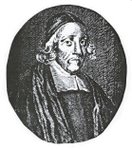Aspects of Piety 04
In 1614, Adams accepted an appointment as Vicar of Wingrave, Buckinghamshire, residing there until 1618. (See here). Like his previous calling it was facilitated by Thomas Egerton, Baron Ellesmere. Buckinghamshire and Bedfordshire are adjacnet and Adams’ early years of ministry were all spent in the same vicinity. (See map). While at Wingrave, he seems to have taken up a lectureship at St Gregory’s in London, a church dating from the 7th Century near to the old St Paul’s Cathedral. It was destroyed in the Great Fire of 1666. (The site is now occupied by the clock tower of St Paul’s according to Angus, Works 3, p xi).
Lectureships, especially popular in London, were a Puritan attempt to promote preaching. ‘These lecturers (almost entirely called and supported the laity) created a situation in which much of the preaching in the city took place outside of normal ecclesiastical lines of authority’ (Mark Dever, Richard Sibbes Puritanism and Calvinism in late Elizabethan and early Stuart England, p 81). A full study can be found in Seaver.
Lectureships, especially popular in London, were a Puritan attempt to promote preaching. ‘These lecturers (almost entirely called and supported the laity) created a situation in which much of the preaching in the city took place outside of normal ecclesiastical lines of authority’ (Mark Dever, Richard Sibbes Puritanism and Calvinism in late Elizabethan and early Stuart England, p 81). A full study can be found in Seaver.
The ODNB also mentions a chaplaincy at this time to Sir Henry Montague, later Earl of Manchester, the Lord Chief Justice or Privy-seal. Adams dedicated his works of 1629 to Montague and to William, Earl of Pembroke, Lord Chamberlain and privy counsellor, founder of Pembroke College, Oxford. Immediate successors of both served in the Westminster Assembly. His 1633 work on 2 Peter was dedicated to the eminent civil lawyer and judge Sir Henry Marten.
During the Wingrave years, Adams published several collections of sermons and was in demand as a popular city preacher. He retained his lectureship at St Gregory’s until at least 1623, but as, following the Synod of Dort, King James became increasingly pro-Arminian and discouraged lectureships (even before Laud began outlawing them), this probably came to an end.
During the Wingrave years, Adams published several collections of sermons and was in demand as a popular city preacher. He retained his lectureship at St Gregory’s until at least 1623, but as, following the Synod of Dort, King James became increasingly pro-Arminian and discouraged lectureships (even before Laud began outlawing them), this probably came to an end.
By 1619 Adams was rector of nearby St Benet’s, Paul’s Wharf. (The church was replaced after the Great Fire by a red brick Wren church, now home to London Welsh episcopalians. See here.) He resided there it seems until his death, dependent on fluctuating funds available to St Paul’s. In December 1623 his wife died. There is no evidence that he remarried.
Still much in demand, he preached his final sermons at Paul’s Cross in 1623 and 1624. The Temple commemorated King James’s preservation from the gunpowder plot. Three Sermons, 1625, suggests continued prominence as it includes sermons for the Lord Mayor’s election, the triennial visitation of the Bishop of London and mourners at Whitehall two days after King James’s death.
Still much in demand, he preached his final sermons at Paul’s Cross in 1623 and 1624. The Temple commemorated King James’s preservation from the gunpowder plot. Three Sermons, 1625, suggests continued prominence as it includes sermons for the Lord Mayor’s election, the triennial visitation of the Bishop of London and mourners at Whitehall two days after King James’s death.







No comments:
Post a Comment